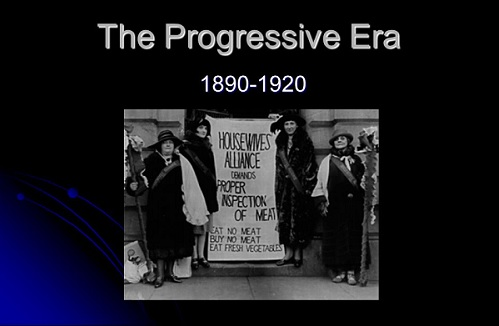Unit 10: The Progressive Era (1890-1917) Overview
Unit 10: The Progressive Era (1890-1917)

Unit 10: The Progressive Era (1890-1917)

Unit 10: The Progressive Era (1890-1917)
The Progressive Era was a period of widespread social activism and political reform across the United States, from the 1890s to 1920s. The main objective of the Progressive movement was eliminating corruption in government. The movement primarily targeted political machines and their bosses. By taking down these corrupt representatives in office, a further means of direct democracy would be established. They also sought regulation of monopolies (“trust-busting”) and corporations through antitrust laws. These antitrust laws were seen as a way to promote equal competition for the advantage of legitimate competitors. The main statutes are the Sherman Act of 1890, the Clayton Act of 1914, and the Federal Trade Commission Act of 1914.
Many Progressives supported prohibition in the United States in order to destroy the political power of local bosses based in saloons. At the same time, women’s suffrage was promoted to bring a “purer” female vote into the arena. These two issues in the movement brought about constitutional change. The Eighteenth Amendment, passed in late 1917, banned the manufacturing, sale, and transport of alcohol, while the Nineteenth Amendment, passed in 1919, gave women the right to vote.
Another theme was building an Efficiency movement in every sector that could identify old ways that needed modernizing, and that could bring to bear scientific, medical, and engineering solutions. A key part of the Efficiency movement was scientific management, or “Taylorism.” Although scientific management as a distinct theory or school of thought was obsolete by the 1930s, most of its themes are still important parts of industrial engineering and management today. These include analysis, synthesis, logic, rationality, empiricism, work ethic, efficiency and elimination of waste, and standardization of best practices.
Many activists joined efforts to reform local government, public education, medicine, finance, insurance, industry, railroads, churches, and many other areas. Progressives transformed, professionalized, and made “scientific” the social sciences, especially history, economics, and political science. In academic fields, the day of the amateur author gave way to the research professor who published in the new scholarly journals and presses.
Initially the movement operated chiefly at local levels; later, it expanded to state and national levels. Progressives drew support from the middle class, and supporters included many lawyers, teachers, physicians, ministers, and business people. Some Progressives strongly supported scientific methods as applied to economics, government, industry, finance, medicine, schooling, theology, education, and even the family. They closely followed advances underway at the time in western Europe and adopted numerous policies, such as a major transformation of the banking system through the creation of the Federal Reserve System in 1913. Reformers felt that old-fashioned ways meant waste and inefficiency, and they eagerly sought out the “one best system.”
Vocabulary
Lesson Reading
Videos and Interactives (Click on Images to View Content)

